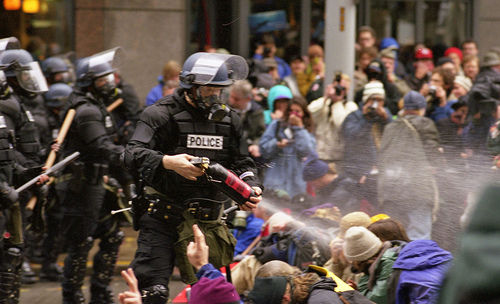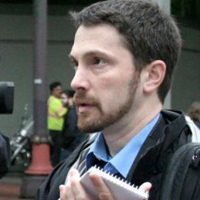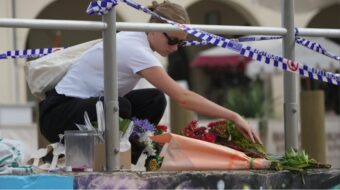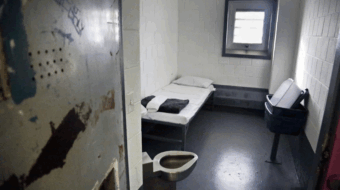
SEATTLE (PAI)—Ten years ago on Nov. 30, 1999, 50,000 people protested a meeting of the World Trade Organization (WTO) in Seattle. The protests succeeded in delaying the summit’s opening day, and contributed to the collapse of plans for a new round of trade negotiations. It was one of those rare moments in history when ordinary people rise up and can no longer be ignored. It was a week of protest, and a coming-out party for a broad-based movement to oppose the “business-first” model of globalization.
This year, in Seattle and elsewhere, union, environmental and community activists will take time in the coming weeks to remember the protests and strategize how to carry forward the “Spirit of Seattle.”
Before the Seattle protests, few people ever heard of the WTO, a secretive organization, headquartered in Geneva, Switzerland, that promotes and enforces multi-national trade agreements. But the world public was increasingly aware that growth in worldwide trade did not benefit workers or the environment.
WTO didn’t create the offshoring of U.S. manufacturing jobs. U.S. trade balances were tilting in China’s direction long before that country joined the WTO, for example. And Mexico had begun creating duty-free “maquiladora” export-processing zones in the 1960s. But the WTO served to “grease the skids,” by lowering tariff and “non-tariff” barriers to trade. For its corporate clients, workers’ rights are among those “barriers.”
The WTO is like a slow motion coup d’état,” Lori Wallach, Director of Public Citizen’s Global Trade Watch, told the Northwest Labor Press. “It’s the main delivery mechanism for the model of corporate globalization we’ve seen implemented in the last couple (of) decades. And it imposes policies that go way beyond trade: Deregulation, privatization, and promotion of offshoring to countries with the lowest wages.”
Since 1947, nations had committed, in the multilateral agreement known as the General Agreement on Tariffs and Trade (GATT), to gradually lower tariffs and quotas for manufactured goods and some commodities. Tariffs – taxes on imports – are a tool countries use to protect domestic industries from foreign competition.
Meeting in Uruguay in 1986, GATT nations began negotiating an agreement that went further. A treaty signed in Morocco in 1994 committed to reducing all “non-tariff” barriers to trade, expanded GATT to agriculture, services, capital investment, and so-called “intellectual property;” and created the WTO to enforce it and resolve disputes.
Signatory nations are supposed to treat all other WTO members the same. That means, for one thing, that a country can’t restrict trade with countries, like China, that abuse workers rights or the environment.
But not all interests are equal at the WTO, said AFL-CIO trade policy expert Thea Lee: The bias is toward the interests of multinational corporations.
“The labor movement’s view,” Lee said, “is that to the extent that we will continue to be in a global economy, we need to make sure the rules of that global economy are taking care of working people and the environment, not just corporate profits.”
In 1999, labor leaders and environmental and community activists learned the WTO would hold a summit at the Washington State Convention Center in downtown Seattle. They began putting resources into a response.
For months leading up to the meeting, they made extraordinary efforts to educate people about the WTO, and reached out to other groups to coordinate a week of protests. Organized labor focused on a rally and march on Tuesday, Nov. 30, 1999 – Day One of the meeting. Seven staff organizers assigned by the national AFL-CIO worked for two months to prepare.
The International Longshore and Warehouse Union resolved to shut down Washington state ports for the day so members could take part. Other unions paid lost wages so members could get off work to attend. The Machinists committed to turn out 900 members to serve as parade marshals. The Steelworkers scheduled an annual conference for Seattle just before the WTO meeting, reserving 500 hotel rooms.
The International Confederation of Free Trade Unions scheduled its annual meeting in Seattle as well, drawing unionists from more than 100 countries. Each local labor council in Washington organized three to 10 busloads, and labor councils in Colorado, Montana, and British Columbia organized bus and car caravans. The Oregon AFL-CIO chartered and filled a 350-seat Amtrak train, while other Oregon labor organizations accounted for 15 more buses.
Meanwhile, environmental activists and anti-sweatshop groups in the Seattle area and on college campuses throughout the Pacific Northwest prepared for early-morning street blockades intended to prevent delegates from getting to the meeting.
On Nov. 30, all that preparation bore fruit. In the early morning, 15,000 mostly-student demonstrators achieved what few had thought possible: Halting the WTO meeting by preventing delegates from getting to the convention center. Using physical barriers and “lock-down” tactics borrowed from anti-logging protests, they held intersections even when police used pepper spray and physical force.
Meanwhile, 20,000 people, mostly unionists, attended a rally in Memorial Stadium, and then were joined by another 15,000 in “feeder marches” in a permitted march to downtown. But as marchers neared the Convention Center, they found the streets full of people. The procession ground to a crawl, and split into at least three streams, with some mingling with the protesters blocking intersections.
Steve Hughes, today a union rep at Oregon AFSCME Council 75, was then part of a group of The Evergreen State College students occupying an intersection near the Convention Center. Police were menacing the group all morning. Fatigue was setting in and spirits were sagging, when all of a sudden, a group of guys in hard hats behind an Iron Workers banner showed up and stayed to reinforce the intersection.
“The WTO was one of those moments where there was a crack in the facade and we got a taste of our power,” Hughes says. “It was a vision of how different groups could work together and how our causes are interrelated.”
The presence of tens of thousands of unionists and their families meant it would be politically disastrous for police to keep trying to clear intersections with force and chemical agents. By mid-afternoon on Nov. 30, with delegates still unable to get in, WTO leaders cancelled the day’s session.
As night fell, the police cracked down. Some in the crowd responded by setting fire to dumpsters. Seattle Mayor Paul Schell declared a curfew and the formation of a “no-protest” zone. Police pursued protesters out of downtown and into the nearby Capitol Hill neighborhood. Most of the day’s protesters – union members off work for the day, students who’d skipped classes – returned home.
By morning, two dozen blocks in the core of downtown Seattle were a militarized zone where anyone who protested would be arrested on sight. Police – who’d stood by the day before while anarchists and delinquents broke windows and spray-painted corporate storefronts – now rushed in aggressively at any sign of protest.
Police arrested 630 people in all, bused them to a special Federal Emergency Management Agency (FEMA) detention center at the mothballed Sand Point Naval Station, and held them there and at King County Jail for up to five days. Shoppers, bystanders, reporters and politicians were swept up. Anyone going into the street could find themselves choking on tear gas, as did Rep. Peter DeFazio, D-Ore. Over the next few days, police repression of basic rights came to overshadow other issues.
On Day Four of the WTO summit, the talks collapsed when delegates from less-developed countries walked out. For protesters, it was a victory beyond what they could have imagined. For advocates of WTO-style “free trade” pacts, it was a debacle. The protests punctured a perception of inevitability and/or omnipotence free-traders enjoyed.
“It was a radicalizing experience,” said Stan Sorscher, a trade activist and union rep for the Society of Professional Engineering Employees in Aerospace Local 2001 at Boeing. “People who participated in it talk about it in semi-religious terms.”
“This was taking on world powers,” recalls Jeff Johnson, Washington State Labor Council legislative director. “It was unprecedented. Here you have all these world leaders and you’ve exposed what they’re doing: Meeting behind closed doors. They’re not interested in having honest discussion about the repercussions of trade on people.”
Ripples from the event continued for months and years. In Seattle, Police Chief Norm Stamper resigned. Mayor Schell lost re-election. A federal jury agreed the city of Seattle violated protesters’ free speech rights, and the city paid $1 million to settle the suit, filed on behalf of protesters arrested for violating the “no-protest zone.”
Attempting to recreate Seattle, thousands of protesters united at the 2000 Republican and Democratic conventions, and at international summits in Washington, D.C., Miami, Genoa, Italy, and Cancun, Mexico. None had the impact of Seattle.
Local police and national governments resolved never to allow a repeat of Seattle, and police spied on groups and disrupted them, created barriers, and used preemptive mass arrests and physical intimidation.
A year after the Seattle WTO protests, the U.S. Supreme Court selected George W. Bush as president. Labor’s energies were absorbed in defense against a hostile White House, a recession, and the economic and political fallout of the 9/11 attacks. Campus activism shifted to other causes, including opposition to the war in Iraq.
But free-traders never fully recovered from the protests, and have been on the defensive ever since. Attempting to rally, the WTO held its next meeting in 2001 in Doha, Qatar, a state ruled by a monarch who forbade all forms of protest. At Doha, the WTO achieved what eluded it in Seattle – a declaration of commitment to a new round of negotiations. But the negotiations never led to an agreement. A 2003 WTO summit in Cancun collapsed in similar fashion to the Seattle summit.
After Seattle, free-traders adopted the rhetoric of protesters, saying it was important that labor and environmental concerns be considered. But labor and green groups were not fooled and continued to oppose new international trade agreements.
In 2005, the GOP majority in Congress passed CAFTA (a NAFTA-style agreement with Central America). But by then a shift occurred among Democrats. Whereas 102 House Democrats voted for NAFTA in 1993, just 15 voted for CAFTA. When Democrats regained the majority in 2007, they stripped the White House of the “fast track” authority needed to negotiate future trade agreements. It has not been restored.
And Democrats in Congress have signed up in droves to support a labor-backed bill that calls for the renegotiation of NAFTA, the WTO, and other agreements, and sets labor and other standards for new trade agreements. That measure, the TRADE Act of 2009, has 127 co-sponsors in the House.
The next WTO summit kicks off in Geneva, Switzerland on Nov. 30, exactly 10 years after protesters shut it down in Seattle. In Geneva, there will be protests; in Seattle and elsewhere, remembrances.
Don McIntosh is the associate editor of The Northwest Labor Press and a PAI contributor.
Photo: http://www.flickr.com/photos/djbones/ / CC BY-SA 2.0










